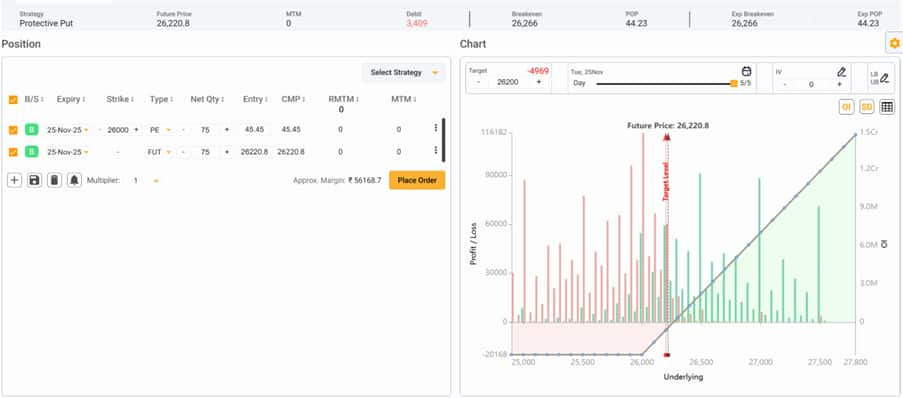Ratio Spreads: One of the best option trades if handled with care: Shubham Agarwal
Ratio Spreads would give a lot of advantage against the peril of Time Value Decay.The stop loss would be minuscule and over passage of time would outperform single Call.
SHUBHAM AGARWAL | 24-Oct-20
Reading Time: 3 minutes

They say options are dangerous instruments, I say they are like Sports Car. Options do the Job well if we use them carefully, knowing all that they are capable of, the good, the bad and the ugly.
Ratio spreads are such race car strategies that could beat any other strategy if deployed correctly, but it also has a capacity to create an unforgettable dent on the trading portfolio if mishandled.
Selling of options has time and again caught fancy of many option traders and many have succeeded in it also as they know the pitfalls and know when to call it quits early or even with a tiny loss. Ratio Spreads also involve net selling options, but with a directional twist.
Let us first discuss how to create Ratio Spreads. Here we have one Buy position in an option coupled with multiple Sell positions in another Option of the same stock and same expiry date. Typically, a Call Ratio Spread would involve Buying a Call Option with a strike close to current market price and Selling 2 Lots of at least 2 steps higher Strike Call Options. Similarly, a Put Ratio Spread would involve buying a near CMP Put strike and selling 2 lots of at least 2 steps lower Put options.
Many such ratios are constructed with different multiples also. So, instead of 1:2 (1 Buy and 2 Sell), one may go for 2:3 or 3:5 combination as well. Here the element of risk due to the extra sold option gets reduced a little bit, however, it does exist.
So, the obvious threat here is the additional selling which is done. It brings in a threat of losing out on super performance in our favour due to the additional option sold. But there are always time and place for everything.
Ratio spreads also has such a time in expiry and placement of the underlying, which creates ground for selection of this strategy.
With time what we mean is, the last 3-5 sessions of the expiry, when the time value decay is at its highest and that is where the single options bought might be out done in terms of stock price sensitivity by the time value decay.
That is the right time when we could deploy Ratios starting from last Friday of the expiry. Quite possibly even if it takes a couple of sessions, a three to four strike apart ratio would let one have profits when the stock reaches the sold strike. Maximum profits would be made when the underlying ends up close to the Sold Strike level upon expiry.
In case, of an unfavourable move (fall in case of Call Ratio Spread and vice versa), the losses would be limited to the net premium paid, which is generally lower as the premium paid would get decent compensation from the premium received by selling multiple options.
About the placement of the underlying, Ratio spreads benefits when there is a move up to (for call ratios)/ down to (for put ratios) the sold strike level but does not go any further up or down than that. Such a situation would arise when there has been a huge rise and there is a risk of the rally being fizzled out into a consolidation.
Similarly, the same situation could be on the lower side when after a big drop, the underlying is expected to slow down the fall. While the Call Ratios are very popular, Put Ratios have not been a primary choice. This is because during the fall the implied volatility impacting the premiums will always be on a rise.
In case we go wrong and the fall accentuates we not only get hit by additionally sold option but also by all the option premiums going higher. Remember, we have sold more options than bought, hence this development will doubly hurt our strategy.
Of course, Ratio Spreads would give a lot of advantage against the peril of Time Value Decay. The stop loss would be minuscule and over the passage of time would outperform single Call.
However, this race car strategy must be done when the time and place is right. Also, Ratio Spreads should be done by ones who can follow a STRICT stop loss of underlying crossing the Sold Strike. If you ask me, I have also had an Absolute Loss exit mechanism, which would be a tiny fraction of the maximum money I can make.
The moment there is a loss on a position that crosses your predetermined Absolute Stop Loss level or if the Sold Strike level is achieved, one will have to make sure the entire trade is exited.
The exit strategy should be tightly executed especially while Booking of Profits or it could turn ugly.
Only then one can get the thrills of a race car without meeting with a fatal accident.
(The author is CEO & Head of Research at Quantsapp)
Disclaimer: The views and investment tips expressed by investment experts on Moneycontrol.com are their own and not that of the website or its management. Moneycontrol.com advises users to check with certified experts before taking any investment decisions.
Learn and read more about What are derivatives from Quantsapp classroom which has been curated for understanding of futures contract from scratch, to enable option traders grasp the concepts practically and apply them in a data-driven trading approach.
Recent Articles

Evolve Your Trade: The missing step in most trading systems: Shubham Agarwal
06-Dec-25

Best trending option trading strategies: Shubham Agarwal
29-Nov-25

3 best ways to hedge using Options: Shubham Agarwal!
22-Nov-25

When in doubt to write, do Iron Fly: Shubham Agarwal!
15-Nov-25

Identify potential turning points with advance-decline: Shubham Agarwal
08-Nov-25

Slow and spreads more efficient: Shubham Agarwal
01-Nov-25

Use implied volatility as probable top finder: Shubham Agarwal
25-Oct-25

How to trade potential breakout post consolidation: Shubham Agarwal!
18-Oct-25

SHUBHAM AGARWAL is a CEO & Head of Research at Quantsapp Pvt. Ltd. He has been into many major kinds of market research and has been a programmer himself in Tens of programming languages. Earlier to the current position, Shubham has served for Motilal Oswal as Head of Quantitative, Technical & Derivatives Research and as a Technical Analyst at JM Financial.
Recent Articles

Evolve Your Trade: The missing step in most trading systems: Shubham Agarwal
06-Dec-25 20:43:00

Best trending option trading strategies: Shubham Agarwal
29-Nov-25 09:32:00

3 best ways to hedge using Options: Shubham Agarwal!
22-Nov-25 09:11:00

When in doubt to write, do Iron Fly: Shubham Agarwal!
15-Nov-25 10:48:00

Identify potential turning points with advance-decline: Shubham Agarwal
08-Nov-25 10:35:00

Slow and spreads more efficient: Shubham Agarwal
01-Nov-25 10:35:00

Use implied volatility as probable top finder: Shubham Agarwal
25-Oct-25 09:56:00











